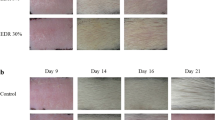Abstract
Purpose
Alopecia is one of the most common side effects of chemotherapy for which treatments have not been developed. In the present study, we evaluated the effects of sodium zinc dihydrolipoylhistidinate (DHLHZn), a new derivative of the multifunctional antioxidant α-lipoic acid, to treat chemotherapy-induced alopecia.
Methods
Wistar rats (8 days old) were treated with cytosine arabinoside (AraC; 20 mg/kg by daily intraperitoneal injection; days 0–6) and DHLHZn (0%, 0.5%, or 1% topically applied in a white petrolatum base; days 0–12). A control group received daily saline injections (days 0–6) and topical application of white petrolatum (days 0–12). On day 12, we evaluated hair loss and histologic changes to scalp tissue for each group (n = 10).
Results
Rats treated with AraC and 0% DHLHZn cream exhibited complete hair loss; however, treatment with 0.5% or 1% DHLHZn significantly reduced chemotherapy-induced hair loss. Histological analysis revealed that AraC treatment promoted inflammatory cell infiltration of the hair follicles, but this inflammatory response was attenuated by DHLHZn.
Conclusions
Our findings demonstrate that DHLHZn attenuates chemotherapy-induced alopecia, indicating the potential use of this α-lipoic acid derivative as a therapeutic agent against this common side effect of chemotherapy.
Similar content being viewed by others
References
Sausville EA, Longo DL. Principles of cancer treatment. In: Fauci AS, Braunwald E, Kasper DL, Hauser SL, Longo DL, Jameson JL, editors. Harrison’s principles of internal medicine. 17th ed. New York: McGraw-Hill; 2008. p. 514–533.
Schilli MB, Paus R, Menrad A. Reduction of intrafollicular apoptosis in chemotherapy-induced alopecia by topical calcitriolanalogs. J Invest Dermatol 1998;111:598–604.
Jimenez JJ, Roberts SM, Mejia J, Mauro LM, Munson JW, Elgart GW, et al. Prevention of chemotherapy-induced alopecia in rodent models. Cell Stress Chaperones 2008;13:31–38.
Wang J, Lu Z, Au JL. Protection against chemotherapy-induced alopecia. Pharm Res 2006;23:2505–2514.
Duvic M, Lemak NA, Valero V, Hymes SR, Farmer KL, Hortobagyi GN, et al. A randomized trial of minoxidil in chemotherapyinduced alopecia. J Am Acad Dermatol 1996;35:74–78.
Hesketh PJ, Batchelor D, Golant M, Lyman GH, Rhodes N, Yardley D. Chemotherapy-induced alopecia: psychosocial impact and therapeutic approaches. Support Care Cancer 2004;12:543–549.
Conklin KA. Dietary antioxidants during cancer chemotherapy: impact on chemotherapeutic effectiveness and development of side effects. Nutr Cancer 2000;37:1–18.
Chen Y, Jungsuwadee P, Vore M, Butterfield DA, St Clair DK. Collateral damage in cancer chemotherapy: oxidative stress in nontargeted tissues. Mol Interv 2007;7:147–156.
Wollin SD, Jones PJ. Alpha-lipoic acid and cardiovascular disease. J Nutr 2003;133:3327–3330.
Poh ZX, Goh KP. A current update on the use of alpha lipoic acid in the management of type 2 diabetes mellitus. Endocr Metab Immune Disord Drug Targets 2009;9:392–398.
Novotny L, Rauko P, Cojocel C. Alpha-lipoic acid: the potential for use in cancer therapy. Neoplasma 2008;55:81–86.
Ogata K, Sakaue T. The new material development of the alpha lipoic acid derivative. Fragrance J 2007;35:74–78.
Viele CS. Managing oral chemotherapy: the healthcare practitioner’s role. Am J Health Syst Pharm 2007;64:S25–S32.
Gregoriou S, Papafragkaki D, Kontochristopoulos G, Rallis E, Kalogeromitros D, Rigopoulos D. Cytokines and other mediators in alopecia areata. Mediators Inflamm 2010;2010:928030.
Mills PJ, Ancoli-Israel S, Parker B, Natarajan L, Hong S, Jain S, et al. Predictors of inflammation in response to anthracycline-based chemotherapy for breast cancer. Brain Behav Immunol 2008;22:98–104.
Abushamaa AM, Sporn TA, Folz RJ. Oxidative stress and inflammation contribute to lung toxicity after a common breast cancer chemotherapy regimen. Am J Physiol Lung Cell Mol Physiol 2002;283:L336–L345.
Botchkarev VA, Komarova EA, Siebenhaar F, Botchkareva NV, Komarov PG, Maurer M, et al. p53 is essential for chemotherapyinduced hair loss. Cancer Res 2000;60:5002–5006.
Goldberg MT, Tackaberry LE, Hardy MH, Noseworthy JH. Nuclear aberrations in hair follicle cells of patients receiving cyclophosphamide. Arch Toxicol 1990;64:116–121.
Norberg E, Orrenius S, Zhivotovsky B. Mitochondrial regulation of cell death: processing of apoptosis-inducing factor (AIF). Biochem Biophys Res Commun 2010;396:95–100.
Quiroz Y, Ferrebuz A, Romero F, Vaziri ND, Rodriguez-Iturbe B. Melatonin ameliorates oxidative stress, inflammation, proteinuria, and progression of renal damage in rats with renal mass reduction. Am J Physiol Renal Physiol 2008;294:F336–F344.
Author information
Authors and Affiliations
Rights and permissions
About this article
Cite this article
Hagiwara, S., Uchida, T., Koga, H. et al. The α-Lipoic acid derivative sodium zinc dihydrolipoylhistidinate reduces chemotherapy-induced alopecia in a rat model: A pilot study. Surg Today 41, 693–697 (2011). https://doi.org/10.1007/s00595-010-4481-z
Received:
Accepted:
Published:
Issue Date:
DOI: https://doi.org/10.1007/s00595-010-4481-z




